Kaj Halberg - writer & photographer
Travels ‐ Landscapes ‐ Wildlife ‐ People
India & Nepal 1978: Journey towards Everest
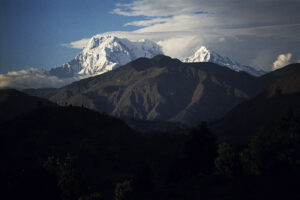
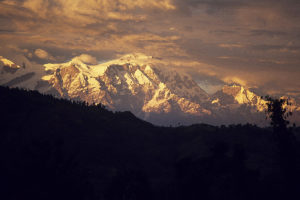
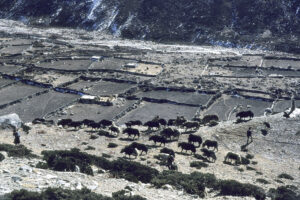
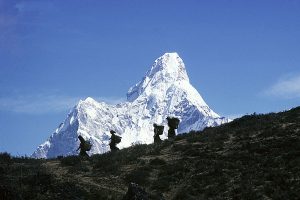
In Delhi, I buy a ticket for a three-day bus trip to Kathmandu. Many buses ply this route, because most hippies and ‘freaks’ choose this very uncomfortable, but cheap way to travel. As I plan to stay in Asia for at least six months, I must count my pennies, so in order to save money I choose the same manner of transportation.
The passengers make up a flamboyant and jolly crowd. Most of them are long-haired and wear colourful garments, which have just been purchased at one of the Delhi markets. I and a few others wear old duds from home, but a single Dutchman stands out from the crowd, wearing a noble suit. His name is Krabowski, indicating that he is of Polish descent, and he makes a living, selling Tibetan carpets back in Holland. Maybe his company is not doing too well, since he has to employ this manner of transportation, but that said he is a nice guy, who is not the least condescending towards the hippies or people like me, wearing worn trousers and down-at-heel shoes.

In these parts there are no rules concerning working hours of bus drivers, and as our bus has only one driver, he gets alarmingly tired in the early hours. For this reason, the Dutchman, who previously has been driving buses, takes over the wheel.
I doze off, but shortly before dawn I am awoken by a tremendous crash. To avoid hitting a cycle rickshaw, Krabowski has hit one of these circular concrete ‘islands’ in the centre of a road crossing, at which, during daylight hours, a police officer is doing his best to keep a minimum of order in the chaos, which Indian traffic constitutes. Naturally, there is no officer present at this time of the night, where traffic is almost non-existing.
One pair of rear wheels on our bus have become crooked, and the baggage compartment has a huge dent. Our Nepalese staff loosen the wheel bolts, whereupon they reverse the bus into the concrete ‘island’, in this ingenious way straightening the wheels. The dent is repaired with a hammer – an indispensable tool on board Nepalese busses.
A wit among the hippies at once dubs Krabowski The Flying Dutchman, named after the legendary ghost ship, which, it is said, since the 1600s has cruised the stormy seas south of Africa, where it charges at full sails – also when the sea is dead calm. According to folk lore, this ship is a portent of doom for anyone who sees it.
The day has begun, and we continue our journey across the dusty Ganges Plain, passing one village after another, and occasionally a stinking industrial town, where factory chimneys emit huge quantities of black smoke into the already misty landscape. In spite of the damaged wheels, our driver races along the lousy roads, but, strangely enough, the ‘repair’ seems to be adequate.
Lots of Indian black kites (Milvus migrans ssp. govinda) and Indian white-backed vultures (Gyps bengalensis) are soaring over the fields, and gorgeous Indian rollers (Coracias benghalensis) take off from the thickets. In puddles along the road, birds like black-winged stilts (Himantopus himantopus), pond herons (Ardeola grayii), and yellow-billed egrets (Mesophoyx intermedia) are feeding.
[In 1978, vultures and kites were extremely common all over India, but since the 1990s, all species of Indian vultures have declined alarmingly due to poisoning from diclofenac, a veterinary drug widely used to treat diseases in livestock. Research has shown that when these vultures feed on cattle carcasses, which contain diclofenac, it will destroy their livers. The kite has also diminished, mainly due to less available garbage.]
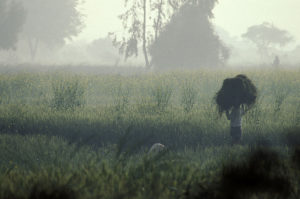
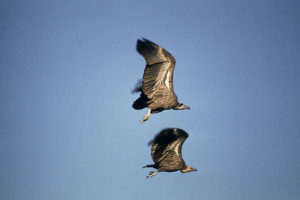
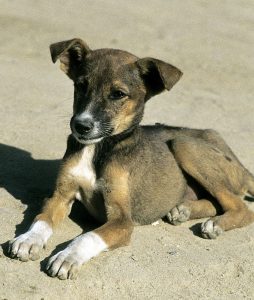
The first part of Nepal is flat like India, but soon we enter the low foothills of the Himalaya. A young musician enters the bus, entertaining us for many miles, singing while mangling a fiddle-like instrument. On the whole, hippies are generous people, who are happy to support poor musicians, so our entertainer has made a packet. He is very happy when he leaves the bus.
In this area, the farmers, naturally, work as hard as farmers do in India, but they do seem a bit prouder and more erect – not stooping and haggard as Indian farmers. Everywhere, they are seen carrying huge loads, mostly on their back, a woven band tied around the burden and then around their forehead. These people must have enormously strong neck muscles.
During a break at the road side, ‘The Flying Dutchman’ gets into an argument with one of the other passengers. The latter throws some dirt on him, whereupon the Dutchman declares that if this act is repeated, he will be after him. When his opponent again throws dirt, Krabowski jumps up and grabs hold of a tree branch, swinging towards his opponent to kick him. But, alas – the branch breaks, and he ends up in a muddy ditch, the branch draped over him.
”The Flying Dutchman,” somebody at once comments from the crowd, ”now you’re not respectable enough to represent ’Krabowski International’.”
Towards evening, we pass through a gorge, at the end of which a magnificent view is unfolded, as the yellowish-orange evening sun illuminates a chain of gigantic, snow-clad mountains. This is the famous Annapurna, named after the Hindu goddess of crops.
We continue a couple of miles west to spend the night in Pokhara – the ultimate paradise of ’freaks’. As soon as we leave the bus we are surrounded by a crowd of young men, who ask, ”You want hash, cocaine, mushrooms?”
The mushrooms are huge, resembling the common edible mushroom of Europe, but famous for their rather large content of psilocybin, a hallucinogen, which is also found in a small European fungus, named liberty cap (Psilocybe semilanceata).
I am accommodated in a private home with three or four other travellers. The resident family retreats to a wattle-and-daube hut at the back – in their eyes, housing four or five tourists is quite profitable. We go out to eat, but do not find much local lore in the restaurant – Western food, Western music, the air thick from hash smoking. Let me get into the mountains as quickly as possible!
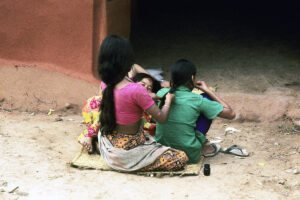
’Freak Street’ is the popular name of a street, where most hash-smokers hang out. When I stroll down the street, young men approach me, whispering if I want drugs, change money on the black market, or sell anything.
A row of trees near the new Royal Palace constitute the day-roost for hundreds of Indian flying foxes (Pteropus medius), huge fruit bats, which are hanging in the trees, head down. At dusk, they leave the trees in search of over-ripe fruit, while spotted owlets (Athene brama) emit their distinctive hissing scream, sounding like anything but a hooting owl.
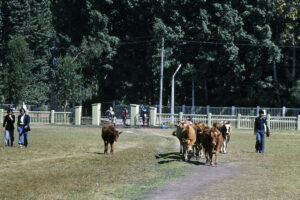
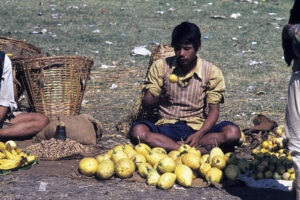
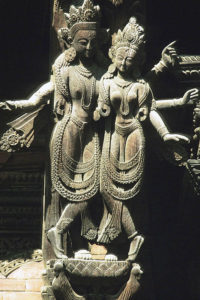
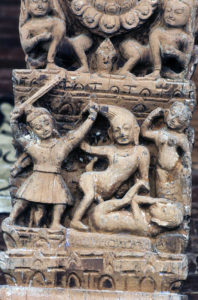
The second day of Tihar, called Kukur Tihar, celebrates the close bond between humans and the dog (kukur). On this day, all dogs, including stray dogs, are worshipped by placing a tika mark of red dye on their forehead and placing garlands of marigolds around their neck. Afterwards they are given all kinds of treats.
The third day, called Gai Tihar, celebrates the sacred cow (gai), which produces a wealth of gifts for humans, including milk, cheese, ghee (clarified butter), urine, and dung. The cow is also the mount of Lakshmi, the goddess of wealth, who is celebrated in the evening. I stroll down the streets, which are illuminated by countless small oil lamps, with rows of lamps leading into the house entrance, so that Lakshmi can find her way to the family cash-box and fill it up. Music is played in temples and private homes, and you are welcome to sit down and listen.
Lakshmi and other Hindu gods are described in depth on the page Religion: Hinduism.
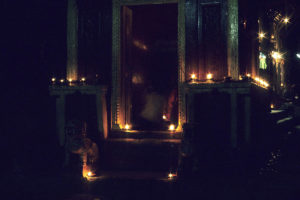
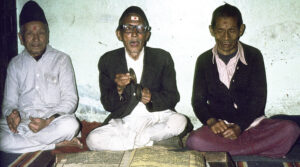


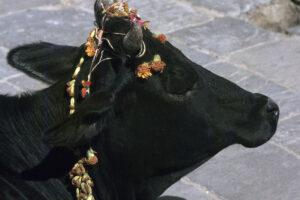
When I enter the office, there is this strange American, walking around and asking everybody: “Would you like to trek with me to Everest Base Camp?”
Here I am, a timid young man from little flat Denmark, who has never been trekking in Nepal before. I have come to do a bit of hiking and to watch birds – not to do any great deed. We talk a bit, and I inform him that maybe the Everest trek will be a little too hard for me. I deliver my application for a trekking permit to a less demanding area and leave the office. However, I have only walked about a hundred yards, before I think: “Hmm, he did sound quite interesting – maybe I should join him anyway.”
I go back to the office, where the American is still searching for a companion, and inform him about my change of plans.
“Great”, he says, “my name is John Burke. And yours?”
Before I met John, he had hooked up with two Austrian sisters, Helga and Heidi, who are also going to the Everest area. Now, if there are any tough women in this world, it must be the Austrian women. John thought so, too, after meeting them, and that is his reason for wanting another companion, who is more like him – a less experienced trekker.
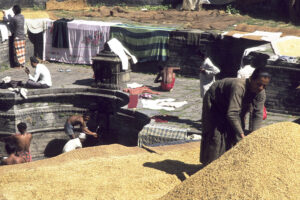
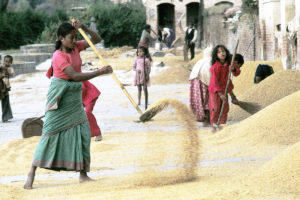
Off we go behind Helga and Heidi – at full speed. Trying to keep up with these formidable women is quite a challenge for beginners like us, but luckily the first part of the trail leads down to the Dudh Kosi (’Milky River’). The whitish water in this river is caused by suspended powder, which glaciers are grinding off the rocks around the source of this river.
Along the trail is low secondary forest, heavily lopped. This valley is densely populated, and the forest has been cut down for timber and firewood. Many of the deciduous trees are very colourful, displaying red and yellow autumn foliage. Flowering herbs are sparse at this time, I only observe self-heal (Prunella vulgaris) in bloom. I also notice red berries of Rubus nepalensis, the leaves of which resemble those of cloudberry (R. chamaemorus). Its berries are even more tasty than cloudberries, being slightly sour and sweet at the same time.
We overtake a group of tourists, walking in a long line. Their porters carry all sorts of equipment, such as food, cooking utensils, tents, sleeping bags, mattresses, dining tent, toilet tent, and also table and chairs, so that their clients can eat with style.
We pitch our tents near a small tea shop, where we have our evening meal. To our great dismay, we discover that during our stay here, a cooking pot, a piece of cheese, and some sausages and nuts are stolen from our scanty rations.
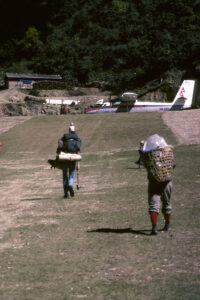
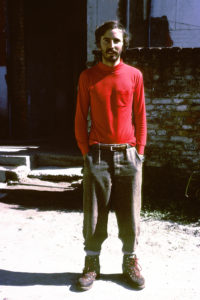
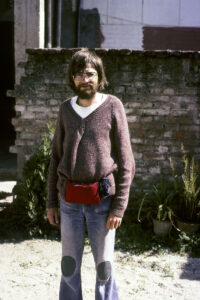
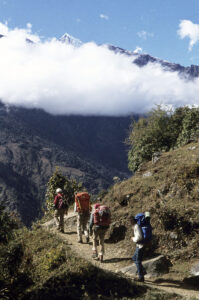
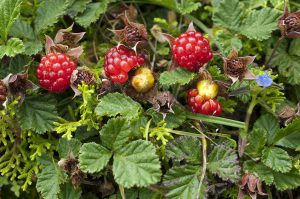
Since time immemorial, extensive trading has taken place between Sherpas and Tibetans, the latter bringing salt and yak hides over the high mountain passes, which separate the two countries. These articles were traded for cereals, tea, and sugar. This trade was interrupted, when the Chinese invaded Tibet in the 1950s, but these days they have slackened the restrictions a bit, and the trade has been taken up again on a smaller scale.
On the market day, all sorts of goods are displayed for sale in the steep streets of the village, including cereals, vegetables, kitchen ware, agricultural tools, tennis shoes, plastic sandals, whole yak heads, and dried carcasses of goats, where skin and intestines have been removed.
Everything is so interesting that I forget my camera on a stone wall in the centre of the market. However, when I return some minutes later, it is still there, untouched. Apart from a little pilfering, which we experienced the previous day, theft is virtually unknown in these parts.
Near Namche Bazaar is a huge rock, one side of which is completely covered in chiseled Buddhist mantras. Such decorated rocks or stone slabs are called mani stones. The most common mantra is Om Mani Padme Hum, which loosely translates as ‘Hail Jewel in the Lotus Flower’. The lotus plant has gorgeous flowers, which contrast sharply with the polluted water, in which the plant often grows. Thus, it symbolizes purity in a dirty world, whereas the jewel, naturally, is the Buddha. – Mani stones and other aspects of Buddhism are described in depth on the page Religion: Buddhism.
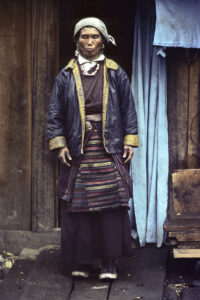
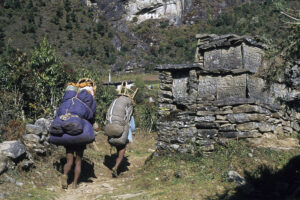
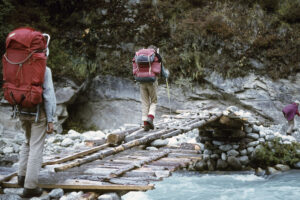
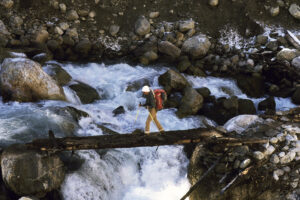
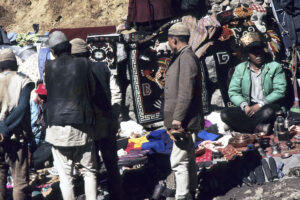
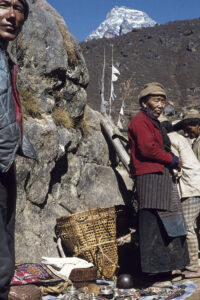
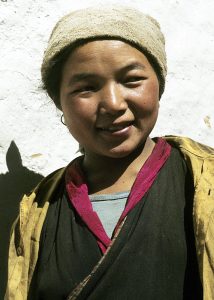
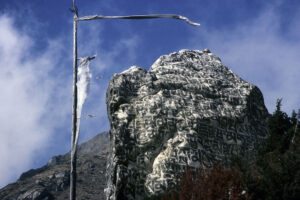
The following day, we enjoy a much-needed rest day, only paying a short visit to the hospital in the nearby village of Kunde. The power for the hospital is delivered by a small hydro-electric plant, which also deliver electricity to nearby villages. This initiative was started by Sir Edmund Hillary – a New Zealand mountain climber. He and Nepalese Tenzing Norgay Sherpa were the first people to scale Mount Everest, in 1953.
Due to over-exploitation, the forests of Khumbu had begun to look a little ravaged, and it was Hillary’s hope that the construction of power plants would diminish the pressure on the forests. The inhabitants, however, only use the power for a few electric bulbs, whereas cooking, which is by far the largest consumer of wood, is still done the traditional way.
The following morning, we make a steep descent to Dudh Kosi, followed by a likewise steep ascent through a magnificent forest of rhododendron, Himalayan birch (Betula utilis), and Himalayan silver fir (Abies spectabilis). Tengboche, the most important gompa (Tibetan Buddhist monastery) in Khumbu, is situated on a ridge, surrounded by stupendous mountains. – You may read more about gompas on the page Religion: Buddhism.
We pitch our tents near the monastery, and the severe cold drives us into our sleeping bags early. The morning is also very cold, as the sun does not appear over the mountains until about 8 o’clock.
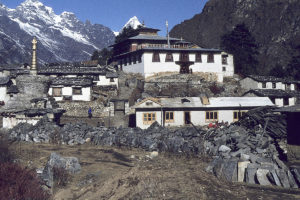
Crossing the Imja Khola, a tributary to Dudh Kosi, we continue past the village of Pangboche to another village, Dingboche, situated at an altitude of 4,350 m, beneath Ama Dablam. No forest can grow at this altitude, and the vegetation consists of low thickets of juniper (Juniperus), sea-buckthorn (Hippophae), and barberry (Berberis), with scattered grazing grounds and fields.
We get permission to pitch our tents in a harvested field of barley. The crop has been placed on tarpaulins, and the owners are busy making bundles from the straw. Several jet-black red-billed choughs (Pyrrhocorax pyrrhocorax), which have seen their chance to eat some of the crop, are chased away by the boys, who shout and throw pebbles at them.
Roasted barley flour, called tsampa, is a main staple food of Tibetan peoples. The flour is mixed with hot or cold water, or tea, to a porridge-like substance, which is then eaten. Thus, tsampa is easy to make a quick meal from – very convenient when travelling.

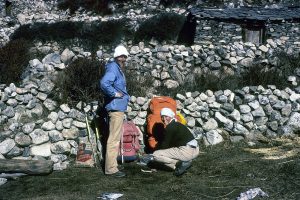
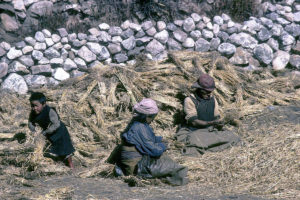
A few hours later, we arrive at a small cluster of hotels, named Chhukung (4,750 m). I feel extremely uncomfortable, dizzy and nauseous, and John is not feeling good either. We both have an attack of AMS (Acute Mountain Sickness), a condition caused by lack of oxygen in your body. At this altitude, the air contains less than two thirds of the amount of oxygen, found at sea level.
Our condition is undoubtedly caused by our forced hike. Consequently, we decide to split from the Austrians and walk at our own pace. I think they are just as relieved as we are – to get rid of beginners like us. To get better, we must return to Dingboche the same day, and once we are back here, we immediately feel much better.
As John and I are afraid of experiencing another attack of AMS, we never make it to Everest Base Camp. However, we still enjoy ourselves tremendously, walking slow and steady while discussing numerous issues. Each of our camp sites is situated in a magnificent landscape, and we spend a few days in our familiar field at Khumjung. At night, we can admire the starry sky behind Ama Dablam.
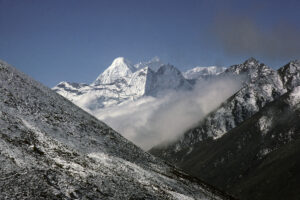
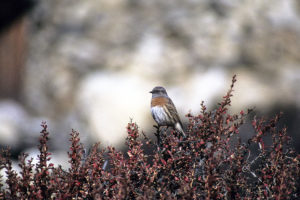
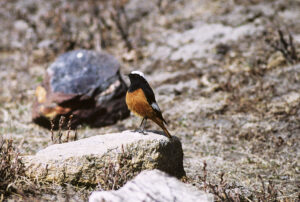

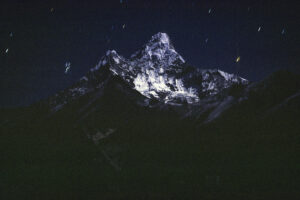
I wait and wait – no John. Dusk, and still no John. I decide to pitch the tent alone. However, besides being a camp ground, the field has an additional function, namely as a toilet, judging from the numerous piles lying here and there. So, putting up our tent here, in the dwindling light, is a painful task – to find a space large enough for the tent, without those piles, is not easy. But I succeed and creep into my sleeping bag.
Later, when it is already pitch dark, John finally returns. He sticks his head into the tent, saying: “Thanks for putting up the tent.”
As I relate my difficulties, he says: “I wouldn’t even have been able to do that myself!”
I urge him to examine the soles of his boots very carefully before entering the tent.

